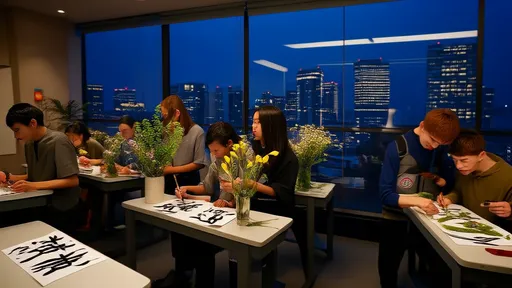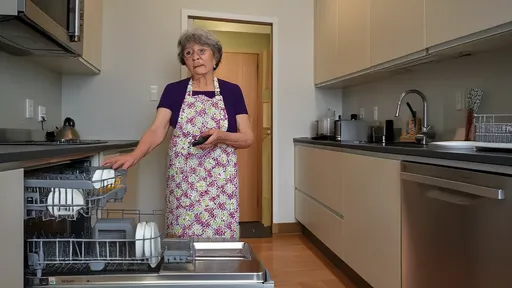In cities across China, a quiet revolution is taking place after sunset. Office towers empty out, but instead of heading straight home, growing numbers of young professionals are rushing to community centers, cultural halls, and specialized studios. Their destination? Night schools offering everything from flower arrangement and calligraphy to pottery and traditional tea ceremony.
The phenomenon, dubbed "night school fever", has taken urban China by storm over the past two years. What began as scattered evening classes in major cities has evolved into a full-blown cultural movement among millennials and Gen Z workers. Enrollment numbers tell the story - Shanghai's premier night school program received over 650,000 applications for just 10,000 spots in their fall 2023 semester.
At first glance, these courses appear to be simple hobby classes. But dig deeper, and they reveal much about the pressures and aspirations of China's young urbanites. For many participants, night school represents more than skill acquisition - it's a form of self-care, social connection, and cultural rediscovery in an increasingly digital and high-pressure work environment.
Take 28-year-old marketing executive Li Jiawei, who spends every Thursday evening learning traditional ink painting. "After staring at Excel sheets and performance metrics all day, dipping my brush into ink feels like meditation," she says. "For two hours, I'm not thinking about KPIs or promotions. I'm just present with the paper and the rhythm of my strokes."
Psychologists point to several factors driving this trend. The pandemic years left many young people craving in-person connections and tactile experiences after prolonged isolation. Meanwhile, the "996" work culture (9am-9pm, 6 days a week) prevalent in tech and finance sectors has created a counter-movement valuing work-life balance and personal development.
Cultural heritage plays a significant role too. Many night school participants consciously choose traditional Chinese arts over Western-style leisure activities. Calligraphy classes often fill up first, followed by guqin (Chinese zither) and porcelain painting. "There's a generational shift happening," observes Professor Chen Ming of Fudan University's Sociology Department. "Young Chinese who grew up during the country's rapid modernization are now seeking roots in their own culture."
The night school model itself is innovative. Unlike expensive private tutors or degree programs, these are affordable, short-term commitments - typically 8-12 weekly sessions costing between 300-800 yuan ($40-$110). Local governments often subsidize the programs through cultural funds, keeping prices accessible. Classes are deliberately scheduled from 7:30-9:30pm, allowing time for participants to commute after work.
Social media has amplified the trend. Platforms like Xiaohongshu (China's Instagram equivalent) overflow with night school attendees sharing their progress - a delicate orchid painted in ink, a hand-thrown ceramic cup, or elegant calligraphy strokes. These posts often go viral, inspiring others to enroll. The hashtag #NightSchoolDiaries has garnered over 180 million views on Douyin (TikTok's Chinese version).
Interestingly, the movement has spawned unexpected economic ripple effects. Art supply stores report surging sales of brushes, inks, and specialty papers. Traditional craftspeople, once struggling to find apprentices, now teach packed evening classes. Even real estate agents note growing demand for apartments near cultural centers offering night programs.
Yet the phenomenon isn't without its critics. Some argue it represents another form of "self-improvement anxiety" plaguing China's competitive urban youth. "There's pressure to constantly optimize every waking hour, even leisure time," notes workplace consultant Zhang Lei. "The question is - are people truly relaxing, or just adding another performance metric to their lives?"
For most participants though, the benefits outweigh such concerns. Software engineer Mark Zhou, who studies classical poetry recitation, describes his night school experience as "productive decompression". "Coding is logical and precise. Reciting Li Bai's verses under moonlight engages completely different parts of my brain. It's not about achievement - it's about becoming a more rounded person."
As the trend grows, night schools are expanding their offerings beyond traditional arts. Popular new additions include urban farming, vintage camera repair, and even traditional Chinese medicine basics. Some forward-thinking companies have begun partnering with night schools to offer classes as employee benefits, recognizing their value in reducing burnout.
The movement shows no signs of slowing. With China's Ministry of Education recently announcing plans to standardize and expand night school programs nationwide, what began as an urban trend may soon become a mainstream cultural institution. For millions of young Chinese, these evening hours of creativity and tradition offer respite from the pressures of modern life - one brushstroke, one floral arrangement, one musical note at a time.
Ultimately, the night school phenomenon reflects deeper societal shifts. In a world of fleeting digital interactions and relentless productivity demands, these gatherings represent something profoundly human - the need to create, to connect, and to find meaning beyond the workplace. As participant Lin Yifei muses while packing up her calligraphy tools after class: "This isn't just about learning skills. It's about remembering who we are when we're not at our desks."

By /Jun 14, 2025

By /Jun 13, 2025

By /Jun 13, 2025

By /Jun 13, 2025

By /Jun 13, 2025

By /Jun 13, 2025

By /Jun 13, 2025

By /Jun 13, 2025

By /Jun 13, 2025

By /Jun 13, 2025

By /Jun 13, 2025

By /Jun 13, 2025

By /Jun 13, 2025

By /Jun 13, 2025

By /Jun 13, 2025

By /Jun 13, 2025

By /Jun 13, 2025

By /Jun 13, 2025

By /Jun 13, 2025

By /Jun 13, 2025